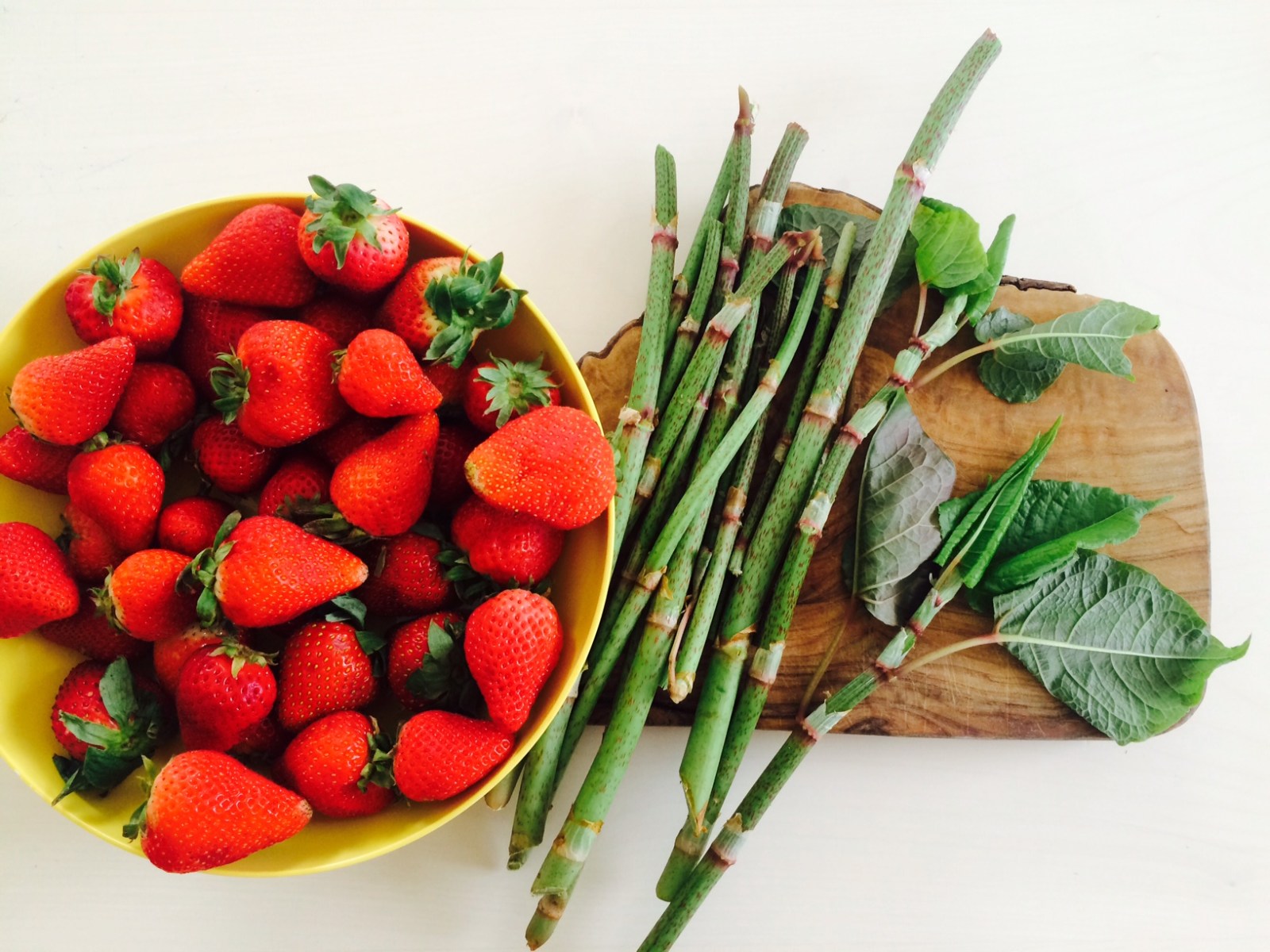Who said foraging and eating wild edibles was all about tree barks in tea and wild and bitter leaves in salads?? Us foragers also love a really yummy PIE! {which that’s not to discount the barks or bitters, btw}.
We all know and love a good strawberry-rhubarb pie in the month of June, when the wild berries are ripe or are getting big and juicy in the garden. But did you know that the invasive Japanese knotweed (Polygonum cuspidatum) can be transformed into a delicious strawberry pie with a similar flavor?
Japanese knotweed is at the top of nearly all of the invasive plant “Most Wanted” lists. It has virtually no known predator, other than foragers, to keep its spread in check. The Japanese knotweed spreads voraciously, lining ditches, streambeds, and woodland fields where there is damp soil. To find a stand of the Japanese knotweed, look for tall stalks left from the previous year as their woody, jointed stems last well into the next season.

The perennial Japanese knotweed’s woody, bamboo-like leafy stalks grow in dense stands, towering in heights up to 10 feet. The new shoots emerge in early spring and are hollow and jointed with red flecks at the joints along the stem. The leaves are heart-shaped, bright green, and arranged alternately along the stem. The plant goes to flower in late summer into early fall, producing feathery clusters of dainty white blossoms.

The early spring shoots are crunchy with a tart, citrusy flavor similar to that of spring rhubarb. Its bright flavors make for a tart simple syrup, good for use in cocktail recipes. The larger stalks can be prepared as you would use rhubarb (unless you are cooking them, then the stalks soften significantly) in summer fruit compotes, jams, or pies. Because the fruit ripens much later than when you harvest Japanese knotweed, its stalks can be chopped and then frozen for later use.
While delicious and edible, many landscape companies and parks management protocols include using agressive herbicides on the plant to stunt its growth. So, be sure the area where you harvest hasn’t been treated with an herbicide meant to eradicate the plant. Look at surrounding vegetation for visible signs of plant burn, or ask the landowner or park manager about herbicide treatment.
One of my favorite Japanese knotweed & berry combo is in a strawberry rhubarb pie. While the strawberries from the garden aren’t ready yet here in the Midwest, the addition of the invasive Japanese knotweed was a delightful “re-wilding” of the grocery-store berries of May coming in from down south and out west (do choose organic – it matters!!).
A Forager’s Strawberry-Knotweed Pie
Preheat oven to 350 degrees. Blend ingredients in a mixing bowl for the filling and add to the prepared pie pan. Bake for 50 minutes until the filling begins to gel and the crust turns a golden brown. Serve with heaping spoonfuls of whipping cream, creme fraiche or vanilla ice cream. Garnish with lavender blossoms for a delightful herbal top note.
You will need:
(1) 9″ pie pan and crust, pan buttered
For filling:
4 cups strawberries
2 cups trimmed Japanese knotweed stalks
3/4 cups white sugar
1/4 cup cornstarch
1/4 tsp salt




Made a Japanese Knotweed – Strawberry Pie, using freshly picked, ripe North Carolina strawberries for the 2014 wild food contest at the North Carolina Wild Foods Weekend in late April. Didn’t win first place, but every last bite disappeared! Lisa’s recipe is very similar to mine, and the pie is definitely worth making. A slice is wonderful when topped with a scoop of vanilla ice cream.
Can’t forget the ice cream!!! 😀
Pingback: 20+ Edible Weeds in Your Garden (with recipes!)
Just found out about Japanese Knotwood. I have a huge patch in my backyard. I wonder if it’s possible to can pie filling like you might can rhubarb pie filling? I may try it later this week. I’ve read that the texture on it can change when you cook it, but I wonder, if like most anything you can, you just blanche it first… that seems to stop any color changes in the canner. Might not stop texture changes. Guess I might wait and see 🙂